Zander & Labisch in Berlin was the first German photo studio that, as a photo agency, dealt exclusively with the production of professional press photos and their direct sales. It was founded in 1895, and at the turn of the century, the photo agency focused on new areas of activity, such as theatre photography. From 1918 on, the studio also produced many portraits of film stars.
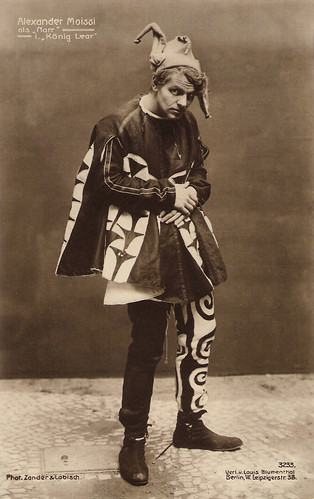
German postcard by Verlag Louis Blumenthal, Berlin, no. 3233. Photo: Zander & Labisch. Alexander Moissi as the fool in 'König Lear' (King Lear).
Albanian-Austrian Alexander Moissi (1879-1935) was one of the great European stage actors of the early-20th century. The attractive and charismatic women's idol also appeared in several silent and early sound films.

German postcard by Verlag Herm. Leiser, Berlin Wilm., no. 1860. Photo: Zander & Labisch. Theodor Loos in the play 'König Salomon' (King Solomon).
Theodor Loos (1883-1954) was a German stage and screen actor between the 1910s and the 1950s. He became famous for his parts in Fritz Lang’s German films.

German postcard by Verlag Hermann Leiser, no. 4553a, Berlin. Photo: Zander & Labisch, Berlin. Paul Wegener in 'Oedipus Rex' (1910).

German postcard by Verlag Hermann Leiser, Berlin, no. 4581a. Photo: Zander & Labisch, Berlin. Tiresias at the palace of Oedipus.
Paul Wegener in 'Oedipus Rex', Sophocles's classic tragedy, directed by Max Reinhardt in a translation by Hugo von Hofmannsthal. This production was first performed in 1910, first in a Summer festival in Munich and then in the Fall in a circus arena Berlin. Stars were Paul Wegener as Oedipus and Tilla Durieux as Jocasta, though some considered the masses of extras performing the Thebans to be the real stars. Emily Bilski, in Berlin Metropolis: Jews and the New Culture, 1890-1918, writes: "Oedipus was the first major theater-in-the-round production in modern times that featured masses of actors performing for a mass audience."
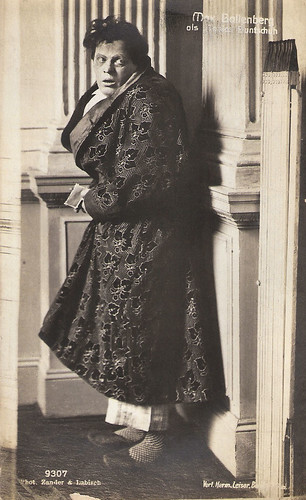
German postcard by Verlag Herm. Leiser, Berlin, no. 9307. Photo: Zander & Labisch. Max Pallenberg in the play 'Tobias Buntschuh' (1917).
Against the background of the development of photo and printing technology and its effects on the print media of the early days, the engineer and photographer Albert Zander (1864–1897) from Colmar near Poznan and the rabbi and photographer Siegmund Labisch (1863 –1942) from Samter in the same region recognised the possibilities and opportunities that arose from the increased demands of publishers, editorial offices and readers with regard to current press photos of good quality.
Albert Zander first worked as an engineer at the Berlin machine factory Carl Flohr. In 1895, a fire broke out at the factory, which was photographed by Zander. Two of his photos were then published by the Berliner Illustrirten Zeitung. A few months later, he and Siegmund Labisch founded a photo studio in Berlin under the company name Zander & Labisch-Illustrations-Photographen. Later they operated as Zander & Labisch Neue Photographische Gesellschaft A.G., and finally as Zander & Labisch oHG.
The photo studio specialised in supplying the press, daily newspapers, magazines and magazines, and was thus involved in the creation of the tabloid press in Germany. The agency was initially located at Leipziger Strasse 105, in the immediate vicinity of important newspaper publishers such as the August Scherl Verlag and the Ullstein Verlag.
The portfolio of the photo studio included current events as well as portrait photos of contemporary personalities that were of interest to the press. Already two years later, about a tenth of all photos published in the Berliner Illustrirten Zeitung were from Zander & Labisch.
In 1897 the photo studio had to search for larger premises and moved to Mohrenstrasse 19, where two of its employees, Olga Badenberg and Waldemar Titzenthaler, previously worked. When Zander suddenly died by poisoning in 1897, Labisch continued to run the photo studio alone but he retained the company name of Zander & Labisch.
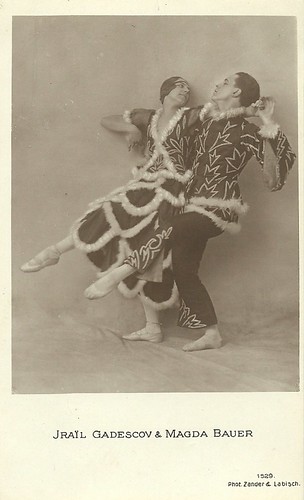
German postcard, no. 1529. Photo: Zander & Labisch. Collection: Didier Hanson.
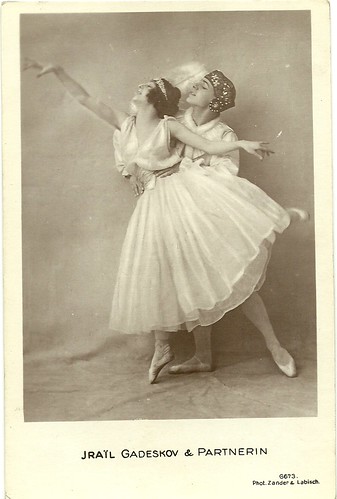
German postcard, no. 6673. Photo: Zander & Labisch. Collection: Didier Hanson.
Iraïl Gadescov was the exotic stage name of the Dutch dancer Richard Vogelesang (1894-1970), who enjoyed an international career. During the 1920s he often performed together with German dancer Magda Bauer. In 1921, Gadescov danced in the German silent film Die Diktatur der Liebe. 1. Die böse Lust/The dictatorship of love I -The evil desire (Willy Zeyn, 1921), credited as Jrail Godescou.

German postcard, no. 3789. Photo: Zander & Labisch, Berlin.
German actress Marianne Winkelstern (1910-1966) became well known as a ballerina in Germany and England. In Germany, she appeared in some silent films and early sound films.

German postcard, no. 4064 . Photo: Zander & Labisch, Berlin.
German film and screenwriter Maria Solveg or Maria Matray (1907–1993) was a star of the late Weimar cinema. When Hitler came to power, the Jewish actress went into exile and had a new career in the US as a choreographer and writer.
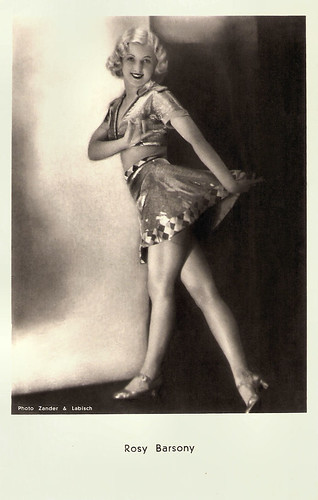
Austrian postcard Iris Verlag, no. 6586. Photo: Zander & Labisch, Berlin.
Hungarian actress, dancer, and singer Rose Barsony (1909-1977) appeared in 16 films from 1929 to 1938, and in one more in 1957. The soubrette was a popular star of the operettas by Paul Abraham.
At the turn of the century, Zander & Labisch focused on new areas of activity, such as architecture, industry, and theatre photography. As a result, the agency found new customers in addition to the press: AEG, Borsig, Osram, and Siemens were among its renowned international clients. The large companies used Zander & Labisch, for example, to have photo documentation of their products made for their company archives, but also for advertising purposes.
The photo agency was also active outside of Berlin. For example, in 1905 Zander & Labisch photographed for the magazine Ost und West - an illustrated monthly magazine for the entire Jewish community.
In 1917, Labisch accepted his nephew Paul Wittkowsky (1892–1949), born in Strasbourg in Alsace, as a co-owner of the company. In 1918 the agency moved from Mohrenstrasse 19 to Leipziger Strasse 115/116. There, rooms for portrait photography were created, on which a separate department specialised. At that time, the photo agency had nine employees, with whom it was able to process the numerous orders of the 1920s.
In 1929, the prominent society magazine Die Dame published five full pages with photos from Alfred Flechtheim's Berlin apartment, which was a celebrity get-together for artists, bankers, writers, journalists, and film and stage stars. The photos were all made by Zander & Labisch.
Their artist portraits were used for many postcards. They made e.g. a popular 'stage stars' series on which artists posed in the costumes of their most famous roles. The autograph of Zander & Labish on the card was a quality label for collectors.

German postcard by Ross Verlag, no. 281. Photo: Zander & Labisch. Caption: Johannes Riemann at the lecture table
German actor Johannes Riemann (1888-1959) appeared from World War I till the end of World War II in some 90 films, often as the gentleman who elegantly breaks a woman’s heart.

German postcard by Ross Verlag, Berlin, no. 337/1, 1919-1924. Photo: Zander & Labisch.
Ernst Lubitsch (1892-1947) was a German-American actor, screenwriter, producer, and film director. His urbane comedies of manners gave him the reputation of being Hollywood's most elegant and sophisticated director; as his prestige grew, his films were promoted as having ‘the Lubitsch touch.’ He was nominated three times for the Oscar for Best Director and in 1947, he received an Honorary Academy Award.
Ossi Oswalda (1895-1947) was one of the most popular comediennes of the German silent cinema.
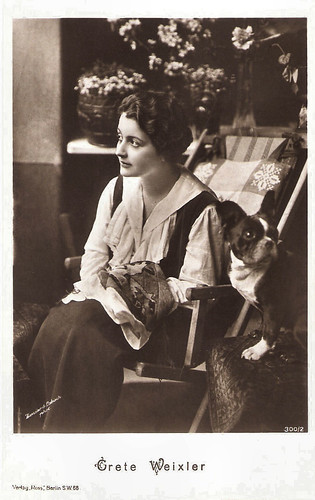
German postcard by Verlag Ross, Berlin, no. 300/2, 1919-1924. Photo: Zander and Labisch.
Grete Weixler (ca. 1900- after 1922) was a German actress of the silent cinema. From 1914 on, she appeared in secondary roles in melodramas by directors like Carl Boese, Friedrich Zelnik, and Lupu Pick.

German postcard by Photochemie, Berlin, no. K. 3076, Photo: Stuart-Webbs-Films / Zander und Labisch.
Ernst Reicher (1885-1936) was a German stage and screen actor, director, screenwriter, and producer, famous for his Stuart Webbs detective films.

German postcard by NPG. Photo: Zander & Labisch, Berlin.
Little is known about German actress Lu L'Arronge. While IMDb lists just one film: Anna Karenina (Friedrich Zelnik 1919), a film in which she only had a minor part, Filmportal.de indicates that she formed her own company in 1919 to star in her own film Die weisse Maus (Leonhard Haskel, 1919) and that she also played the lead in Die Geisterbraut (Herbert Gerdes, 1919).

German postcard by NPG, no. 1419. Photo: Zander & Labisch, Berlin.
Senta Söneland (1882-1933) was a German actress whose peaks in her film career were in the later 1910s and the early 1930s.
The rise of the National Socialists and their anti-Semitism in the early 1930s had a significant impact on Zander & Labisch. The result was a massive drop in sales. Orders from newspaper publishers were increasingly dropped because they were no longer wanted to employ Jewish employees and suppliers. The first layoffs occurred.
In 1936, the agency was banned from the Reich Association of German Correspondence and News Offices e. V. and thus excluded from the superior Reich Press Chamber (RPK). In architecture and industrial photography, however, Zander & Labisch was able to remain active for some time.
In 1938, however, the photo agency had to give up its premises in the Leipziger Strasse. The rest of the business was moved entirely to the private apartments of the two owners, Labisch and Wittkowsky, where they carried out small orders from the private sector.
When the ordinance to eliminate Jews from German economic life came into force, Zander & Labisch had to finally cease business on 31 December 1938. In 1939 the company was deleted from the Berlin commercial register. Paul Wittkowsky emigrated to Australia in 1939.
Siegmund Labisch was deported to the concentration camp Theresienstadt, where he died in 1942.
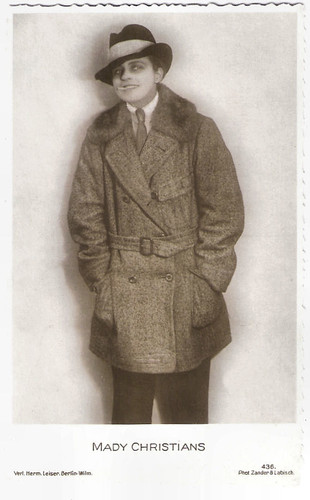
German postcard by Verlag Hermann Leiser. Berlin-Wilm., no. 436. Photo: Zander & Labisch.
Austrian-born stage actress Mady Christians (1892-1951) was a star of the German silent cinema and appeared in Austrian, French, British and Hollywood films too.

German postcard by Ross verlag, no. 298/1, 1919-1924. Photo: Zander & Labisch / Hella Moja Film.
During the First World War and the following years Hella Moja (1890-1951) was one of the most popular stars of the German silent cinema. There was even a Hella Moja serial and in 1918 she founded her own film company.

German postcard by Verlag Hermann Leiser, Berlin-Wilm., no. 9303. Photo: Zander & Labisch. Paul Hartmann in Volk in Not/People in Need (Wolfgang Neff, 1925).
German stage actor Paul Hartmann (1889-1977) made over 100 films, both in the silent and the sound period. Despite his commitment to the Nazi regime, he could continue his career quite smoothly into the 1950s and 1960s.
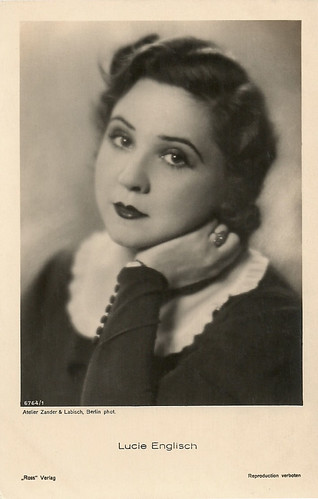
German postcard by Ross Verlag, no. 6764/1, 1931-1932. Photo: Atelier Zander & Labisch, Berlin.
Popular Austrian folk-actress Lucie Englisch (1902-1965) played both leading and supporting roles on stage, in films, and on television. As the native girl with the loose tongue, she was seen in countless comedies, in both leading and supporting parts.

Dutch postcard by Isa-Film, no. 4636. Photo: Zander & Labisch.
Austrian actress Luise Ullrich (1910-1985) starred in many German films of the 1930s, 1940s, and 1950s. No German star played self-sacrificing womanhood better than the blond actress and her film Annelie (1941), became the main morale-booster of World War II Germany.
Sources: Wikipedia (German)

German postcard by Verlag Louis Blumenthal, Berlin, no. 3233. Photo: Zander & Labisch. Alexander Moissi as the fool in 'König Lear' (King Lear).
Albanian-Austrian Alexander Moissi (1879-1935) was one of the great European stage actors of the early-20th century. The attractive and charismatic women's idol also appeared in several silent and early sound films.

German postcard by Verlag Herm. Leiser, Berlin Wilm., no. 1860. Photo: Zander & Labisch. Theodor Loos in the play 'König Salomon' (King Solomon).
Theodor Loos (1883-1954) was a German stage and screen actor between the 1910s and the 1950s. He became famous for his parts in Fritz Lang’s German films.

German postcard by Verlag Hermann Leiser, no. 4553a, Berlin. Photo: Zander & Labisch, Berlin. Paul Wegener in 'Oedipus Rex' (1910).

German postcard by Verlag Hermann Leiser, Berlin, no. 4581a. Photo: Zander & Labisch, Berlin. Tiresias at the palace of Oedipus.
Paul Wegener in 'Oedipus Rex', Sophocles's classic tragedy, directed by Max Reinhardt in a translation by Hugo von Hofmannsthal. This production was first performed in 1910, first in a Summer festival in Munich and then in the Fall in a circus arena Berlin. Stars were Paul Wegener as Oedipus and Tilla Durieux as Jocasta, though some considered the masses of extras performing the Thebans to be the real stars. Emily Bilski, in Berlin Metropolis: Jews and the New Culture, 1890-1918, writes: "Oedipus was the first major theater-in-the-round production in modern times that featured masses of actors performing for a mass audience."

German postcard by Verlag Herm. Leiser, Berlin, no. 9307. Photo: Zander & Labisch. Max Pallenberg in the play 'Tobias Buntschuh' (1917).
The engineer and the rabbi
Against the background of the development of photo and printing technology and its effects on the print media of the early days, the engineer and photographer Albert Zander (1864–1897) from Colmar near Poznan and the rabbi and photographer Siegmund Labisch (1863 –1942) from Samter in the same region recognised the possibilities and opportunities that arose from the increased demands of publishers, editorial offices and readers with regard to current press photos of good quality.
Albert Zander first worked as an engineer at the Berlin machine factory Carl Flohr. In 1895, a fire broke out at the factory, which was photographed by Zander. Two of his photos were then published by the Berliner Illustrirten Zeitung. A few months later, he and Siegmund Labisch founded a photo studio in Berlin under the company name Zander & Labisch-Illustrations-Photographen. Later they operated as Zander & Labisch Neue Photographische Gesellschaft A.G., and finally as Zander & Labisch oHG.
The photo studio specialised in supplying the press, daily newspapers, magazines and magazines, and was thus involved in the creation of the tabloid press in Germany. The agency was initially located at Leipziger Strasse 105, in the immediate vicinity of important newspaper publishers such as the August Scherl Verlag and the Ullstein Verlag.
The portfolio of the photo studio included current events as well as portrait photos of contemporary personalities that were of interest to the press. Already two years later, about a tenth of all photos published in the Berliner Illustrirten Zeitung were from Zander & Labisch.
In 1897 the photo studio had to search for larger premises and moved to Mohrenstrasse 19, where two of its employees, Olga Badenberg and Waldemar Titzenthaler, previously worked. When Zander suddenly died by poisoning in 1897, Labisch continued to run the photo studio alone but he retained the company name of Zander & Labisch.

German postcard, no. 1529. Photo: Zander & Labisch. Collection: Didier Hanson.

German postcard, no. 6673. Photo: Zander & Labisch. Collection: Didier Hanson.
Iraïl Gadescov was the exotic stage name of the Dutch dancer Richard Vogelesang (1894-1970), who enjoyed an international career. During the 1920s he often performed together with German dancer Magda Bauer. In 1921, Gadescov danced in the German silent film Die Diktatur der Liebe. 1. Die böse Lust/The dictatorship of love I -The evil desire (Willy Zeyn, 1921), credited as Jrail Godescou.

German postcard, no. 3789. Photo: Zander & Labisch, Berlin.
German actress Marianne Winkelstern (1910-1966) became well known as a ballerina in Germany and England. In Germany, she appeared in some silent films and early sound films.

German postcard, no. 4064 . Photo: Zander & Labisch, Berlin.
German film and screenwriter Maria Solveg or Maria Matray (1907–1993) was a star of the late Weimar cinema. When Hitler came to power, the Jewish actress went into exile and had a new career in the US as a choreographer and writer.

Austrian postcard Iris Verlag, no. 6586. Photo: Zander & Labisch, Berlin.
Hungarian actress, dancer, and singer Rose Barsony (1909-1977) appeared in 16 films from 1929 to 1938, and in one more in 1957. The soubrette was a popular star of the operettas by Paul Abraham.
New areas of activity
At the turn of the century, Zander & Labisch focused on new areas of activity, such as architecture, industry, and theatre photography. As a result, the agency found new customers in addition to the press: AEG, Borsig, Osram, and Siemens were among its renowned international clients. The large companies used Zander & Labisch, for example, to have photo documentation of their products made for their company archives, but also for advertising purposes.
The photo agency was also active outside of Berlin. For example, in 1905 Zander & Labisch photographed for the magazine Ost und West - an illustrated monthly magazine for the entire Jewish community.
In 1917, Labisch accepted his nephew Paul Wittkowsky (1892–1949), born in Strasbourg in Alsace, as a co-owner of the company. In 1918 the agency moved from Mohrenstrasse 19 to Leipziger Strasse 115/116. There, rooms for portrait photography were created, on which a separate department specialised. At that time, the photo agency had nine employees, with whom it was able to process the numerous orders of the 1920s.
In 1929, the prominent society magazine Die Dame published five full pages with photos from Alfred Flechtheim's Berlin apartment, which was a celebrity get-together for artists, bankers, writers, journalists, and film and stage stars. The photos were all made by Zander & Labisch.
Their artist portraits were used for many postcards. They made e.g. a popular 'stage stars' series on which artists posed in the costumes of their most famous roles. The autograph of Zander & Labish on the card was a quality label for collectors.

German postcard by Ross Verlag, no. 281. Photo: Zander & Labisch. Caption: Johannes Riemann at the lecture table
German actor Johannes Riemann (1888-1959) appeared from World War I till the end of World War II in some 90 films, often as the gentleman who elegantly breaks a woman’s heart.

German postcard by Ross Verlag, Berlin, no. 337/1, 1919-1924. Photo: Zander & Labisch.
Ernst Lubitsch (1892-1947) was a German-American actor, screenwriter, producer, and film director. His urbane comedies of manners gave him the reputation of being Hollywood's most elegant and sophisticated director; as his prestige grew, his films were promoted as having ‘the Lubitsch touch.’ He was nominated three times for the Oscar for Best Director and in 1947, he received an Honorary Academy Award.
Ossi Oswalda (1895-1947) was one of the most popular comediennes of the German silent cinema.

German postcard by Verlag Ross, Berlin, no. 300/2, 1919-1924. Photo: Zander and Labisch.
Grete Weixler (ca. 1900- after 1922) was a German actress of the silent cinema. From 1914 on, she appeared in secondary roles in melodramas by directors like Carl Boese, Friedrich Zelnik, and Lupu Pick.

German postcard by Photochemie, Berlin, no. K. 3076, Photo: Stuart-Webbs-Films / Zander und Labisch.
Ernst Reicher (1885-1936) was a German stage and screen actor, director, screenwriter, and producer, famous for his Stuart Webbs detective films.

German postcard by NPG. Photo: Zander & Labisch, Berlin.
Little is known about German actress Lu L'Arronge. While IMDb lists just one film: Anna Karenina (Friedrich Zelnik 1919), a film in which she only had a minor part, Filmportal.de indicates that she formed her own company in 1919 to star in her own film Die weisse Maus (Leonhard Haskel, 1919) and that she also played the lead in Die Geisterbraut (Herbert Gerdes, 1919).

German postcard by NPG, no. 1419. Photo: Zander & Labisch, Berlin.
Senta Söneland (1882-1933) was a German actress whose peaks in her film career were in the later 1910s and the early 1930s.
The impact of anti-semitism
The rise of the National Socialists and their anti-Semitism in the early 1930s had a significant impact on Zander & Labisch. The result was a massive drop in sales. Orders from newspaper publishers were increasingly dropped because they were no longer wanted to employ Jewish employees and suppliers. The first layoffs occurred.
In 1936, the agency was banned from the Reich Association of German Correspondence and News Offices e. V. and thus excluded from the superior Reich Press Chamber (RPK). In architecture and industrial photography, however, Zander & Labisch was able to remain active for some time.
In 1938, however, the photo agency had to give up its premises in the Leipziger Strasse. The rest of the business was moved entirely to the private apartments of the two owners, Labisch and Wittkowsky, where they carried out small orders from the private sector.
When the ordinance to eliminate Jews from German economic life came into force, Zander & Labisch had to finally cease business on 31 December 1938. In 1939 the company was deleted from the Berlin commercial register. Paul Wittkowsky emigrated to Australia in 1939.
Siegmund Labisch was deported to the concentration camp Theresienstadt, where he died in 1942.

German postcard by Verlag Hermann Leiser. Berlin-Wilm., no. 436. Photo: Zander & Labisch.
Austrian-born stage actress Mady Christians (1892-1951) was a star of the German silent cinema and appeared in Austrian, French, British and Hollywood films too.

German postcard by Ross verlag, no. 298/1, 1919-1924. Photo: Zander & Labisch / Hella Moja Film.
During the First World War and the following years Hella Moja (1890-1951) was one of the most popular stars of the German silent cinema. There was even a Hella Moja serial and in 1918 she founded her own film company.

German postcard by Verlag Hermann Leiser, Berlin-Wilm., no. 9303. Photo: Zander & Labisch. Paul Hartmann in Volk in Not/People in Need (Wolfgang Neff, 1925).
German stage actor Paul Hartmann (1889-1977) made over 100 films, both in the silent and the sound period. Despite his commitment to the Nazi regime, he could continue his career quite smoothly into the 1950s and 1960s.

German postcard by Ross Verlag, no. 6764/1, 1931-1932. Photo: Atelier Zander & Labisch, Berlin.
Popular Austrian folk-actress Lucie Englisch (1902-1965) played both leading and supporting roles on stage, in films, and on television. As the native girl with the loose tongue, she was seen in countless comedies, in both leading and supporting parts.

Dutch postcard by Isa-Film, no. 4636. Photo: Zander & Labisch.
Austrian actress Luise Ullrich (1910-1985) starred in many German films of the 1930s, 1940s, and 1950s. No German star played self-sacrificing womanhood better than the blond actress and her film Annelie (1941), became the main morale-booster of World War II Germany.
Sources: Wikipedia (German)
No comments:
Post a Comment